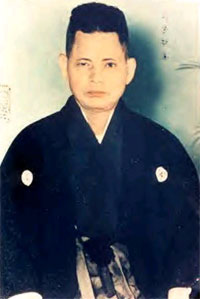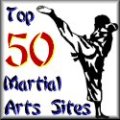
Shimabuku Tatsuo (島袋 龍夫; September 19,
1908 � May 30, 1975) was the founder of
Isshin-ryu ("Whole Heart Style", "One Heart Way") karate.
Shinkichi Shimabuku was born in Kyan
[Chan] village, Okinawa, on September 19, 1908. He was first born of ten
children born into a farming family. By the age of 12, he had a strong
desire to study the martial arts. He walked to the nearby town of Agena,
to the home of his uncle, Shinko Ganiku, a fortuneteller. Shinkichi
primarily learned to be a fortuneteller from his uncle, but also studied
the rudiments of the karate that his uncle had learned while in China.
By the time Shimabuku was a teenager, he had obtained the physical level
of a person six years his senior. His physical condition was due to his
karate training as well as his working on the family farm. He excelled
in athletic events on the island. By the time he was 17, he was
constantly winning in two of his favorite events, the javelin throw and
high jump.
Around the age of 23, because of Shimabuku's desire to further his
knowledge, he began to study Shuri-te, which later became known as
Shorin-ryu (Shao-lin Style) under Chotoku Kyan in the village of Kadena.
He began his training with Master Kyan in 1932. Master Kyan taught
Shimabuku at his home. Kyan also taught at the Okinawa Prefectural
Agricultural School. Within a short time, he became one of Master Kyan's
best students and, under Kyan's instruction, learned the katas: Seisan,
Naihanchi, Wansu, Chinto and Kusanku were taught to Tatsuo along with
the weapons kata Tokumine-no-kun and basic Sai. He also began his study
of "Ki" (or "Chinkuchi; (チンクチ)" in Okinawan dialect) for which Kyan was
most noted. Shimabuku studied with Kyan for several years. He always
considered Master Kyan his first formal Sensei was very loyal to him.
While continuing his studies with master Kyan, Shimabuku sought out
another famous Shorin-Ryu instructor, Master Choki Motobu during the
early 1930s. Choki Motobu was probably the most colorful of all of
Shimabuku's instructors. Motobu had many teachers for short periods of
time, including some notables such as Anko Itosu (Shuri-te) and Kosaku
Matsumora (Tomari-te). Motobu was known for getting into street fights
often to promote the effectiveness of karate.
Shimabuku has always been fascinated by Naha-te (Goju Ryu) and sought
out Master Chojun Miyagi, the founder of Goju Ryu, after Master Kyan's
death. Miyagi's teacher was Higaonna Kanryo (also called Higashionna)
who brought a derivative of Kenpo (拳法): kin gai is the name of this
system. pangai noon is the forerunner of Uechi-ryu) from China to
Okinawa. Eventually this became Naha-te. From Miyagi, Tatsuo learned the
kata Seiunchin ("Seize-Control-Fight") and Sanchin
("Three-Fights/Conflicts").
He opened his first dojo in 1946 after the war in the village of Konbo,
near Tengan village.
Coming from a farming family, Master
Shimabuku has always been poor, yet he was very innovative and
opportunistic. He had a natural talent in adapting things to work for
him. As a young man, he discovered a way to find tile to the roofs of
homes in Chan (チャン) Village without using mud, which had been the
traditional way. Prior to World War II, he saw an opportunity and
started a small business. Purchasing several horses and carts, he
received a contract to help in the construction of Japanese airfield in
Kadena. He was doing quite well until the Allied invasion of Okinawa
began. During one of the bombing raids by Allied forces, his business
was destroyed.
Master Shimabuku continued to study and
develop his skills in both styles, but he was not satisfied that either
style held the completeness he felt a style should have. His interest in
ancient weapons (Kobudo) continued to grow and he sought out the most
renowned weapons instructors on the island for at the time he only knew
bo (staff) kata, Tokumine no Kun and basic sai techniques he learned
from Chotoku Kyan. In a short time, he became a master in such weapons
as the Bo and Sai. (During the late 1950s and early 1960s, he continued
his study of Kobudo with one of Master Yabiku�s top students, Taira
Shinken. This training took place in Master Shimabuku�s dojo in Agena.)
He learned Hama Higa no Tuifa, Shishi no Kun, Chatan Yara no Sai, and
Urashi Bo. Shimabuku created Kyan Chotoku sai and Kusanku sai using sai
techniques he learned from Chotoku Kyan. To honor Chotoku Kyan, he named
his first sai kata after him.
It was during the late 1940s that Master
Shimabuku began experimenting with different basic techniques and Kata
from the Shorin-Ryu and Goju-Ryu systems as well as Kobudo. He comes to
experimenting with his own ideas. He called the style he was teaching
Chan-migwha-te after Chotoku Kyan nickname Chan-migwa (チャンミーグヮー). Master
Kyan�s nickname was �Chan-migwa�, meaning �small-eyed-Chan." "Chan
(チャン)" in the Okinawa dialect �Uchinaguchi� is �Kyan (喜屋武)." In
Uchinaguchi �mi (ミー)� means �eye." The suffix �Gwa (グヮー)� or �Guwa
(グヮー)� mean's �small.� So Chan-migwa means �Small eye Chan (Kyan).� Chan
migwa-te was the style taught until he renamed his style "Isshin-ryu" on
January 15, 1956.
By the early 1950s Master Shimabuku was
refining his karate teaching combining what he felt was the best of the
Shorin-Ryu and Goju-Ryu styles, the weapons forms he had studied, and
incorporating his own techniques. As his experimentation continued, his
adaptation of techniques and katas were not widely publicized. He
consulted with several of the masters on Okinawa concerning his wish to
develop a new style. Because he was highly respected as a karate Master,
he received their blessings. (These would later be rescinded due to the
many radical changes made in traditional Okinawan karate.)
One night in 1955, Mr. Shimabuku fell
asleep and dreamed of a goddess riding a dragon. The goddess was Kannon
(観音)the Buddhist Goddess of mercy and compassion.
Three Stars appeared symbolizing the
three styles Isshin-ryu derived from, Goju-Ryu, Shorin-Ryu, and Kobudo.
The stars can also represent the Physical, Mental, and Spiritual
strength needed for Isshin-ryu. The gray evening sky symbolized serenity
and implies that karate is to be used only for self-defense.
The next morning when Master Shimabuku
awoke, he felt that his dream had been a divine revelation. He met with
his top student, Eiko Kaneshi, and told him of his dream and his desire
to break away from Okinawan tradition and start a new style of karate.
The day was January 15, 1956. Upon announcing his decision to start a
new style, many of his Okinawan students left, including his brother
Eizo.
The new system was not initially given a
name, and in fact, went through 2 name modifications before Isshinryu
was finally adopted. However, the official start of Isshinryu karate is
January 15, 1956. The Isshin-ryu Megami was drawn from Master
Shimabuku�s description by Shosu Nakamine, Eiko Kaneshi�s uncle, and was
chosen to be the symbol for Isshinryu karate.
During his karate career, Master
Shimabuku changed to his name �Tatsuo,� meaning �Dragon Man.�
Whenever asked about this change, Master Shimabuku to apply that
�Tatsuo� was his professional karate name. He also was given the
nickname, �Sunsu�, by the mayor of Kyan (Chan) Village. Sunsu was a name
of a dance that was created by Shimabuku's grandfather.
In 1955, the third U.S. Marine division
was stationed on Okinawa, and the Marine Corps chose Master Shimabuku to
provide instruction to Marines on the island. As a result of his
instruction, Isshinryu was to be spread throughout the United States by
Marines and returned home. The karate that the marines brought back to
the dojos in the United States was a blending of what Master Shimabuku
thought to be the best of the karate systems.
The first of the Marines to bring the
Isshinryu karate to the United States were Don Nagle and Harold Long.
(this is currently in dispute, see Isshinryu article) Don Nagle opened
his dojo at Camp Lejune, North Carolina, while Harold Long�s first dojo
was in his backyard at twenty-Nine Palms, California. Upon their
discharge from service, Nagle moved to Jersey City, New Jersey, and
opened the first Isshinryu dojo in the Northeast. Long returned home to
Knoxville, Tennessee, and opened his first dojo at the Marine Reserve
Training Center.
Returning later were Harold Mitchum,
Steve Armstrong, Ed Johnson, Walter Van Gilson, Clarence Ewing, George
Breed, Jim Advincula, Bill Gardo, and Harry Smith as well as others.
[George Breed began teaching Isshinryu Karate in Atlanta, Georgia in
1961; and then, in Gainesville, Florida from 1966-1969. He remained
independent of the Association.] From this meeting, the Okinawan-American
Karate Association was formed with Harold Mitchum as the association�s
first president. A year later, the name of the association would be
changed to the American-Okinawan Karate Association.
Master Shimabuku made two trips to the
United States to visit with his top students. The first trip was in
1964, and the second in 1966. During his 1966 trip, he visited Steve
Armstrong in Tacoma, Washington, Harold Long in Knoxville, Tennessee,
and Don Nagle in New Jersey. All 3 men were promoted to the rank of
Hachi-Dan (Eighth Degree). Each of these men became a driving force in
the promotion and spread of Isshinryu karate in the United States.
Master Shimabuku was noted to not enjoy travelling far from home, and
further visits representing him were conducted by his students, mainly
Uezu Angi, who was also his son-in-law.
Another important event took place during
this trip. While visiting the dojo of Master Steve Armstrong, Master
Shimabuku was filmed performing all 14 Isshinryu katas as well as some
basic exercise and self defense techniques. Copies of this film were
circulated among the top instructors. It is believed that Master
Shimabuku did not want to be filmed and the recording do not reflect a
true expression of the various kata.
Master Shimabuku continued teaching at
his dojo in Agena until his retirement in early 1972. He passed his
legacy over to his number one son, Kichiro Shimabuku. There was much
controversy over this decision as Master Shimabuku had originally
intended to pass the system onto his number one Okinawan student,
Kaneshi Eiko. When Kichiro learned of this decision, he was outraged and
demanded that his father keep with Okinawan tradition and pass the
system over to him. Master Shimabuku relented and granted his wish, but
their relationship never recovered. Master Tatsuo Shimabuku died on May
30,1975.




